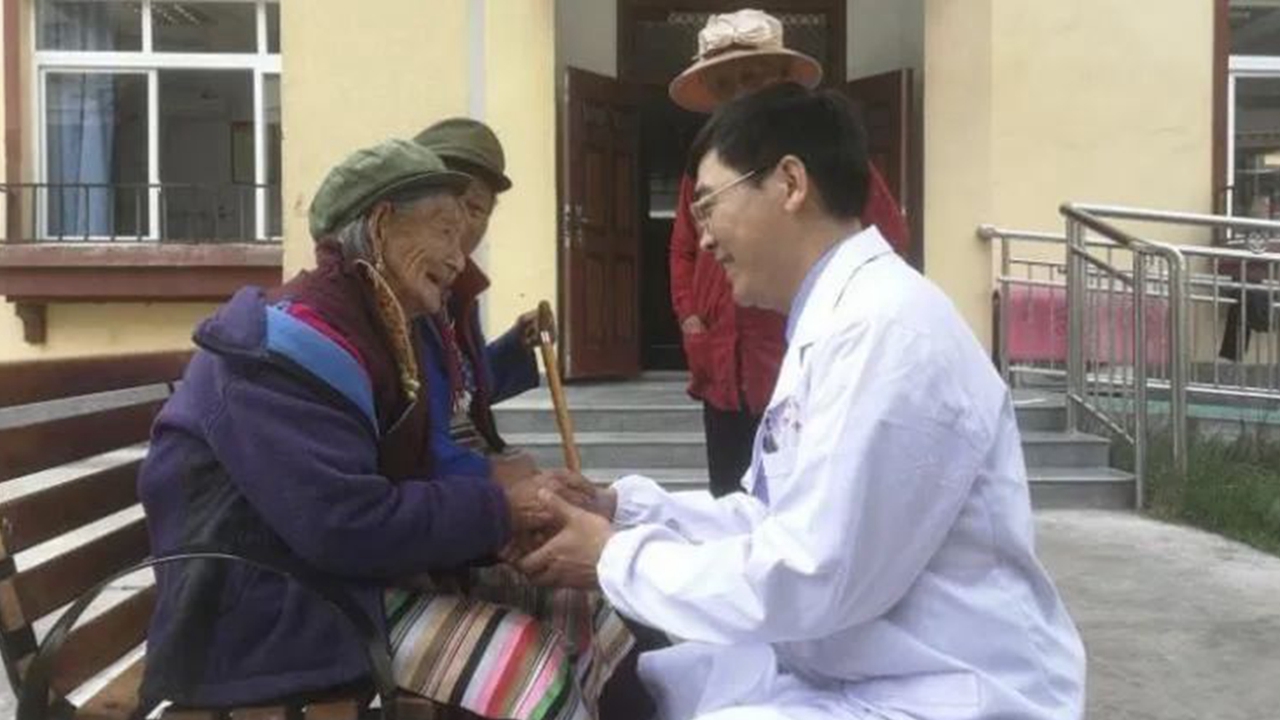Sense of mission sends doctor to snowy plateau
Climbing over Mount Demula, which stands 4,900 meters above sea level, and winding all the way down the mountain road, one would arrive at Chayu County, the farthest border town in the city of Nyingchi in the southeastern edge of the Tibet Autonomous Region.
Residents of the sparsely populated county, bordering Myanmar and India to the south, used to lack access to medical services due to poor transportation, as well as scarce and scattered local medical resources.
On the banks of the county’s Sangqu River, a brand-new hospital now stands, with a clean and well-lit reception area and advanced medical equipment, giving patients the impression that they are at a hospital in a large city.
The hospital, with an investment of 110 million yuan (US$15 million), was jointly funded by Shenzhen’s Bao’an District Government, an aid team from Guangdong Province, and the local government. The hospital was put into use in November 2020.

A woman touches Wang Ganlu’s face after regaining eyesight from a cataract surgery by Wang in Caiyu County of Tibet in 2020. Courtesy of Wang Ganlu
Wang Ganlu, president of Shenzhen Fuyong People’s Hospital in Bao’an District, has contributed to Chayu’s dramatic medical advancement. He was recently named one of the Top 10 Caring Individuals for the year by Shenzhen Project Care, a campaign launched in 2003 that advocates acts of kindness and helping those in need.
Battling adversity
Wang has brought his superb medical expertise to the snowy plateau to cure illnesses for the locals in Chayu, just as his name “Ganlu” implies, which means “nectar” in Chinese and “almighty medicine” in Tibetan.
From 2018 to 2021, Wang volunteered to join a medical team for a hospital pairing-up assistance program between Shenzhen and Chayu, and served as a medical expert stationed in the county.
During that period, Wang often traveled to remote mountain villages and border defense forces for diagnosis and treatment.

Wang Ganlu talks to local senior residents in Tibet in this 2019 photo.
“When making medical house calls, it was normal for me to climb mountains. I encountered collapsed roads, mudslides, avalanches and falling rocks. I once rode a motorcycle perilously close to the edge of a steep cliff,” Wang recalled.
“There might be an accident if I was careless. At such times, I would say to myself, ‘I was doing a good deed to see patients, so I would be blessed,’” he said.
Wang said that at one time, he went to a pasture about 4,500 meters above sea level to see a patient, who had lunch at around 2 p.m. The local shepherd was worried that Wang was not used to eating zanba, a staple food for Tibetans made from roasted qingke flour, so the shepherd cooked him rice using a pressure cooker.
The rice was only about half cooked, and the side dish consisted of a few meatless yak bones and chopped roots (a plant prepared for the yaks to pass the winter), which was sprinkled with a lot of salt without any other seasoning, according to Wang.
“That meal was one of the most difficult ones I had to swallow, but I couldn’t resist my hunger and the sincerity and enthusiasm of the Tibetan people, so I ate two large bowls without hesitation,” Wang said.
On Wang’s way back, the shepherd’s nephew told him that this meal was the best his aunt could offer, and it was cooked as a treat for him. “After hearing his words, my tears fell down and my sense of responsibility and mission as a doctor became even stronger,” Wang added.
In those four years, Wang and his medical team have not only greatly improved medical services of the county hospital, township health centers and village clinics, but also cultivated a group of health care professionals.
Wang’s medical skills have earned him recognition, as the local Tibetan people would affectionately call him “hao men ba,” which means “good doctor.”
Warmth of Shenzhen
After returning to Shenzhen, Wang still cares deeply about Chayu County.
He often goes online, guiding the daily medical work of the local county hospital and township health centers, as well as the village doctors’ training.
He also stays in contact with the local people, helps them analyze their condition, give them treatment plans, and helps Tibetan people who seek treatment in Shenzhen. In some cases, he even performs the surgeries.
“I hope that in the future, medical teams, charitable organizations and caring individuals can work together to help more patients with hard-to-treat diseases in remote areas come to Shenzhen for treatment, so that they can truly feel the warmth of Shenzhen,” Wang said.